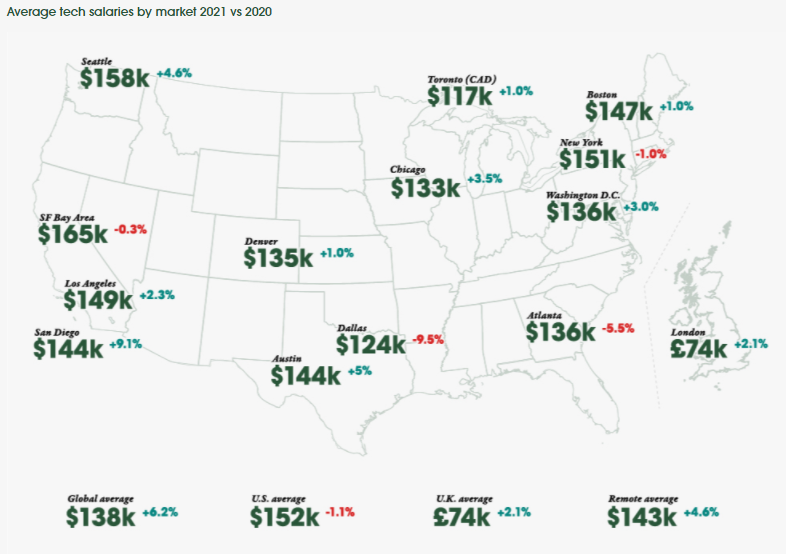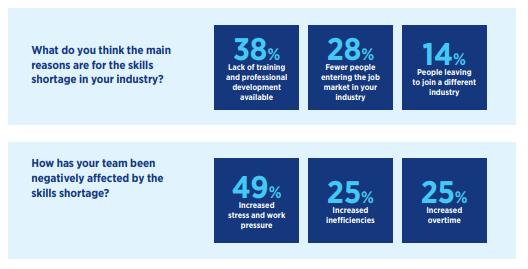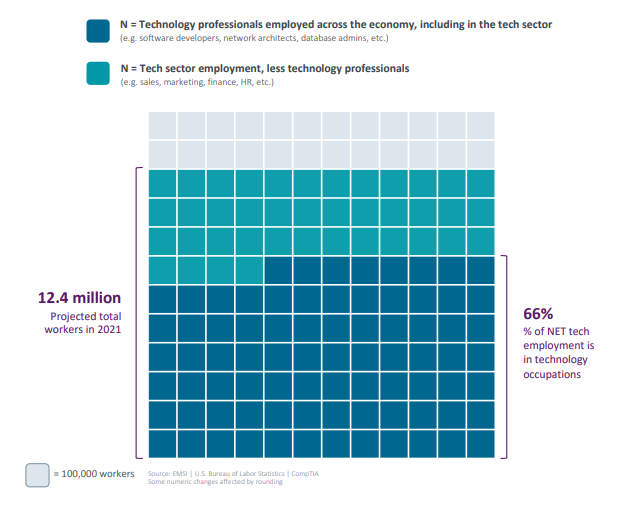Salary trends provide valuable insight about the economy and career opportunities across geographies and industries.
On the plus side, economic surveys and research reports offer data-driven insights into a variety of topics: new technologies, long-term growth, and hiring trends—useful to those in need of new talent and candidates pursuing a career. But these surveys can have some drawbacks. The findings are rarely consistent across reports. For the average reader, the results might be overwhelming or too technical.
That’s why we put together this IT salary roundup: to summarize the most important findings from four popular IT salary research reports and surveys. These results can help you make the right decisions in support of a successful future in the U.S. tech industry.
Hired’s 2021 State of Salaries Report
Hired compiles salary trends across various technologies based on the geographic locations. The report answers key questions, primarily from the perspective of employees. The data is collected widely: from online marketplaces, 525,000 interview requests, 10,000 job offers across 17,000 companies, and 180,000 job seekers between January 2019 and June 2021.
Here are some of the interesting findings from the report:
- Tech-related salaries lead the nation as the Great Resignation trend is causing turnover at significant rates. The highest paying sectors in the U.S. are IT, ecommerce, entertainment, and healthcare.
- Remote work options are necessary and employers are quickly adapting. 52% applicants prefer the remote-first work model, 33% want to stay fully remote. 90% prefer some kind of remote working model.
- Reducing salaries of remote employees increases turnover. 74% would start looking for alternative employment if the salaries are decreased or an expected raise is denied in the next six months.
- Employees want benefits beyond compensation. 76% of employees are willing to accept a lower base salary in favor of other compelling benefits or forms of compensation.
- Employers are expected to be more transparent about compensation. 45% of employees believe that using the cost of living as a factor for calculating baseline compensation is not justified.
- Tech workers want more compensation for their skills and are willing to relocate for it. The tech hub of the San Francisco Bay Area offers the highest average salary at $165,000. But other cities are closing in. When you adjust for cost of living, San Francisco’s salary picture pales in comparison to cost-adjusted salaries in other cities, like Dallas ($243k), Atlanta ($242k), Austin ($234k) and Seattle ($204k).
- Engineers are in high demand. Companies are seeking to fill roles in engineering, particularly full-stack, back-end, and front-end. Expertise in Go and Scala are the most sought among software engineering positions.

Hays 2021 U.S. Salary Guide
The Hays report surveyed over 3,000 professionals and employers in the U.S., across a variety of industry sectors. The research highlights tech-related salary trends and evaluates how the skills shortage affects each industry.
Here are some interesting takeaways from the Hays report:
- Employees are eager to find new opportunities. 51% of employees suggested they are seriously considering alternative roles and opportunities. 25% said they are planning to leave over the next three months.
- Employers are facing budgeting issues. 50% of the respondents said that they intend to quit due to salary offered for their current roles, while employers claim they are strapped for cash and therefore struggle to retain employees.
- The skills shortage has improved—temporarily. 74% of employers face skills shortages, which is a 10% improvement from the previous year. However, the improvement may be temporary due to the “post-pandemic” economic revival.
- Employee engagement for remote work is getting more complicated. 31% of employers claim that they are struggling to keep their employees motivated and engaged toward work obligations, leading to high turnover.
- Economic activity is on the rise. Of those surveyed, 69% expect continued growth in the next 12 months. 73% of Life Sciences employers are the most confident about expected economic improvements.
- Upskilling the current workforce is a lower priority than hiring new talent. Companies seem to seek candidates with currently needed skillsets. Many survey respondents cited a lack of company-paid education programs and incentives.
From the Hays research, we notice two separate but related experiences that might give companies some serious consideration over how to improve employees’ skillsets in order to help them grow and increase attrition.
Employers believe that higher compensation is key to attracting new talent and reducing turnover
Of employer responses, 31% projected increased salaries by 3-5% percent and 56% of explorers expected to increase salaries beyond the expected budget. But, according to the responding employees, money isn’t the only factor. Employees look for these key drivers when taking a new position including:
- Company culture
- Career prospects
- Total benefits package
The skills gap is real
A skills shortage of 74% is observed. Of IT employers, 69% are facing moderate-to-extreme skills shortage:
- Around half these companies want to increase the number of full-time employees but not enough talent is entering the market (28%).
- Nearly one-third (38%) of respondents cite a lack of training and development programs as the number one reason for the overall skills shortage.
Most believe this skills gap is negatively affecting business.

Cyberstates 2021 by CompTIA
The 2021 Cyberstates annual report on the U.S. tech industry by the Computing Technology Industry Association (CompTIA) provides data-rich insights into the IT industry and its workforce. The data is collected from government institutions and large enterprise consulting organizations.
An interactive version is available online. Here are some of the most interesting findings from this report:
- Tech sector well upheld despite pandemic. Net tech employment grew by +2% while all other industry sectors averaged a loss of -0.3%.
- Cybersecurity and Data Scientist occupations are the most in demand. Both are projected to grow by 4.4% in 2021.
- Tech occupation employment outlook is growing exponentially. By the year 2030, an additional 1 million hires are needed to offset retirements and workforce separations. The base workforce will increase from 8 million in 2020 to 9 million in 2030. Demands for cybersecurity and data scientists will increase by 31% and 30% respectively.
- Tech wages are significantly higher than the national wage. The median tech wage of $86.9k is nearly two-times higher than the median national wage, which covers all sectors.
- Software and web development jobs lead the IT sector. There are 1.5 million jobs in software and web development —around twice as many as network and IT support professionals, and cybersecurity analysts (around 750,000 positions each).
- Tech jobs like the coasts. California saw the highest number of new jobs added, followed by Florida, Texas, and North Carolina. California also hosts the highest pool of tech talent (1.8 million net employments), followed by Texas (1,060,000 employments), and New York (670,000).
- Tech workforce lags in diversity. Women average 49% of the workforce in the U.S. nationally, while only 26% engaged in tech occupations. Only 8% of African American and 7% of Hispanic citizens work in tech.

Robert Half predictions
These survey results underscore IT employment trends over the next few years. Half has been tracking salary trends since the 1950s. The 2021 Robert Half report indicates that:
- Disruptive technology trends will continue to impact salaries and career decisions in coming years.
- The talent shortage will prevent many organizations from adopting transformative digital initiatives. 21% of the hiring managers find candidates with the right skills challenging, 16% struggle with retaining top performers.
- Inadequate compensation, slow hiring processes, and lack of IT familiarity will emerge as the biggest barriers to tech talent acquisition. 72% of the applicants lose interest in the job if prospective employers don’t respond in the first two weeks after the initial interview.
The challenge for employers will be to identify, attract and retain new talent with the right skillset before any of their growing number of tech competitors. The challenge for employees is to stay relevant with technology trends, diving deeper into areas of expertise, and knowing your worth in today’s competitive technology market.
Related reading
Explore some more roundups of trends and salaries in other tech areas:







